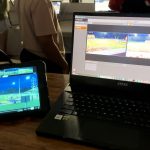Zoom for Remote Production (Chapter 8)
Get in Touch
-
To More Inquiry
(833) 888-9706
-
To More Inquiry
[email protected]
-
534 Trestle Pl, Downingtown, PA, USA
- Home
- Networking Basics (Chapter 9)
Networking Basics (Chapter 9)
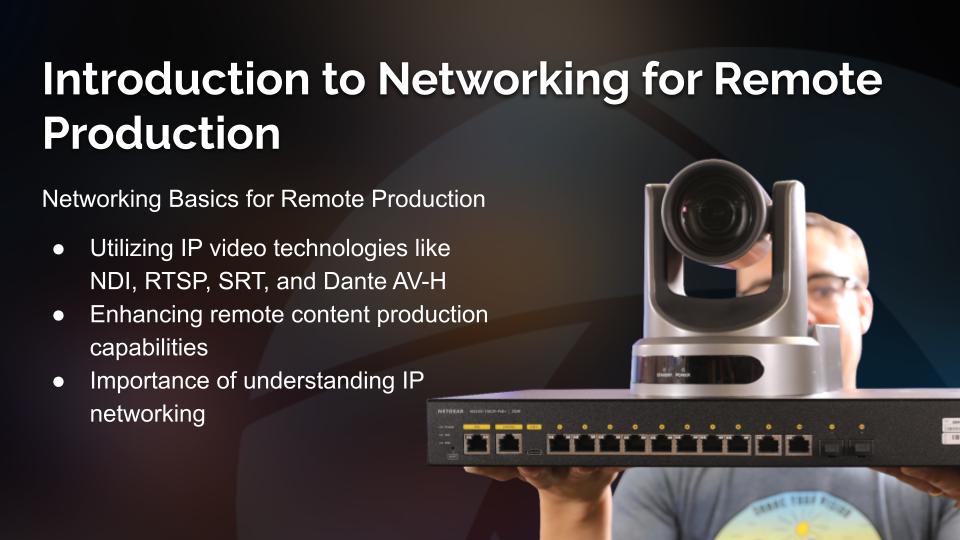
By, Paul Richards
- 7 Aug, 2024
- 363 Views
- 0 Comment
Introduction to Networking for Remote Production
Using common network setups, IP video technologies such as NDI, RTSP, SRT, and Dante AV-H can enhance your ability to produce content remotely. Whether you’re managing IP video remotely through software or streaming all your video signals to the cloud for production, having some knowledge of IP networking will be beneficial.

Networking Basics for Remote Production
- Utilizing IP video technologies like NDI, RTSP, SRT, and Dante AV-H
- Enhancing remote content production capabilities
- Importance of understanding IP networkingEssential Networking Equipment
A router is a common type of networking equipment which provides a safe communication space for computers connected to the network to access the internet. The rules of the LAN are generally managed by the router which has management pages that can be accessed securely by a computer on the network. The router manages the other computers and devices on the network and can even give devices IP addresses automatically using a protocol called Dynamic Host Configuration Protocol (DHCP). Some routers include a built-in network switch, but most are connected to a larger network switch which provides connectivity between all of the devices on the network. Some routers include WiFi connectivity with a built-in Wireless Access Point (WAP). Many networks distribute WAPs throughout an area to provide WiFi connectivity throughout a large space. Each WAP should be connected to the network with ethernet cables and many are Power Over Ethernet (PoE, PoE+ or PoE++) capable; the “+” designations indicating higher available wattage. A PoE device can be powered by PoE enabled networking equipment using standard ethernet cables.
Below is an example of an IP address table. It’s important that you are organized when it comes to managing the 254 IP addresses available on a single IP range, in order to effectively manage your LAN.
IP Address | Address Description |
192.168.1.0 | This is the first network number that identifies the network as a whole. |
192.168.1.1 | Number one is generally assigned to the router |
192.168.1.2-254 | These addresses may be assigned to devices on your network. |
192.168.1.255 | This is the broadcast address. Anything sent to this address is automatically broadcast to IP addresses 1-254. |
21.233.221.1 | This is an example of an outside IP address. An outside IP address is given to you by your Internet Service Provider (ISP). |
The starting numbers can vary depending on how the network is set up.
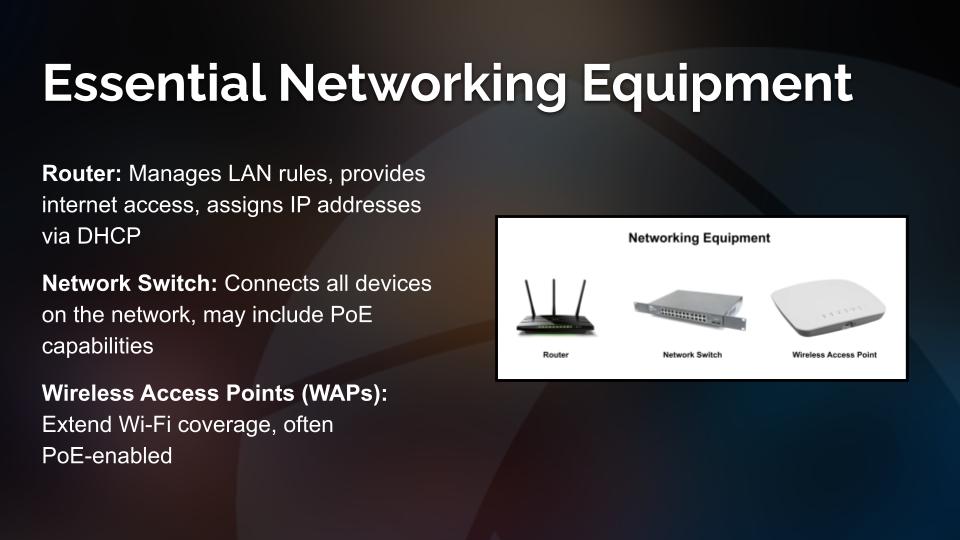
Besides the computers and devices that are a part of the network, LANs require additional hardware to keep everything connected. In a home or small office, the network may be managed by a single router. ISPs often provide multipurpose all-in-one routers that offer access to the internet (via cable, fiber, or other connection). They also provide a wired and/or wireless network connection that enables connected devices to communicate with the internet and other devices on the LAN. Larger and more robust LANs may require additional hardware such as routers, switches, firewalls, and wireless access points. Professional-grade equipment at this level allows for more devices, better security, and network management.
In some situations, the network administrator can prioritize video traffic to reduce latency and avoid issues when there is too much traffic on the network. You may need to set up your own network for use specifically with IP video. It’s possible to connect a computer to multiple LANs at the same time. This is easy to do if your computer has two Network Interface Cards (NICs). If your computer only has one NIC, you can purchase a USB to ethernet adapter to add an additional NIC port to your computer. Adding an additional NIC port will increase the amount of bandwidth your computer can access. Because NDI can load balance multiple NIC cards on a computer, this is an easy way to increase the amount of NDI sources you can use for your video production.
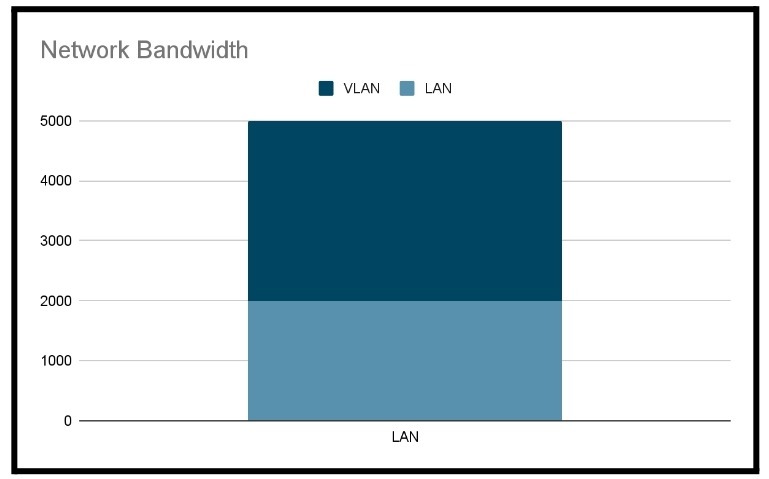
A virtual LAN (VLAN) can be used to set up a segmented part of a network specifically for IP video. Network administrators can set up a VLAN to partition resources inside of a larger LAN and provide additional reliability and security. VLANs are ideal for limiting network access to specific computers and devices. A VLAN is ideal for video traffic because you can reduce network traffic and the potential for packet collisions. Most networking equipment allows you to create a large number of VLANs. Each VLAN can be set up with access to specific resources on the network.
House of Worship Example
The following example will outline a video production network setup for a house of worship. For this example, a part of the network has been segmented for devices that are used for video production such as cameras and computers running video production software. Each device on the network has an IP address and in general, there are two different ways that you can assign devices IP addresses. They can be assigned a static IP address manually, or a dynamic IP address automatically. Static IP addresses never change, and therefore they are much better for managing an IP address table on your network. Dynamic IP addresses are assigned by your router using Dynamic Host Configuration Protocol (DHCP). This protocol is ideal for devices that periodically connect and disconnect from your network. A smartphone is a prime example of an IP-connected device that uses DHCP. When your smartphone connects to WiFi, it automatically gets an IP address from the network. It’s a best practice to assign static IP addresses to the most important devices on your network used for video production. It’s especially important to use a static IP address for devices like PTZ cameras that are permanently installed on your network.
Without getting too far into networking jargon, you can have up to 254 devices on a single network which can all communicate on the same IP range.
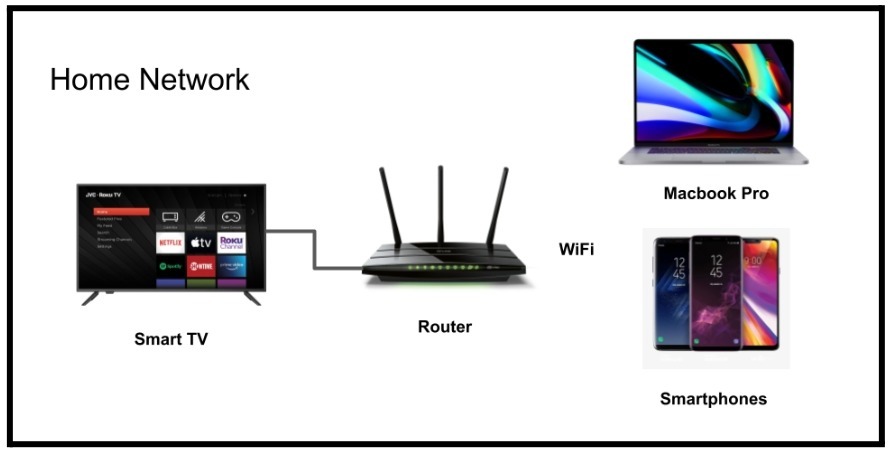
A simple home network like the one above uses a router provided by an ISP. This router includes a built-in network switch, a firewall, and a WiFi access point. A router like this will allow you to connect a few devices to your network right away such as a smart TV, smartphone, and a few computers. All-in-one routers are becoming more popular and affordable and can also be used with NDI®.
Affordable NDI® networking equipment set-up video on YouTube.
One popular networking set-up for NDI comes from TP-LINK. The StreamGeeks tested the TP-LINK Archer series of routers for use with NDI®. This “All-In-One” wireless router offers specific settings that work with multicast and IPTV for video routing. You can scan the QR code above or watch the video in a forthcoming online course to learn more about this set up. Even if you end up using different networking equipment, the six- minute video outlines all the steps required for most routers to be optimized for NDI.
Note: If you plan to power cameras and other devices using ethernet cables, you will want to purchase a network switch that supports Power Over Ethernet (PoE).
The next diagram shows that each device on the network is connected to a network switch. This network switch has PoE connectivity and it can power small devices such as PTZ cameras and joystick controllers.
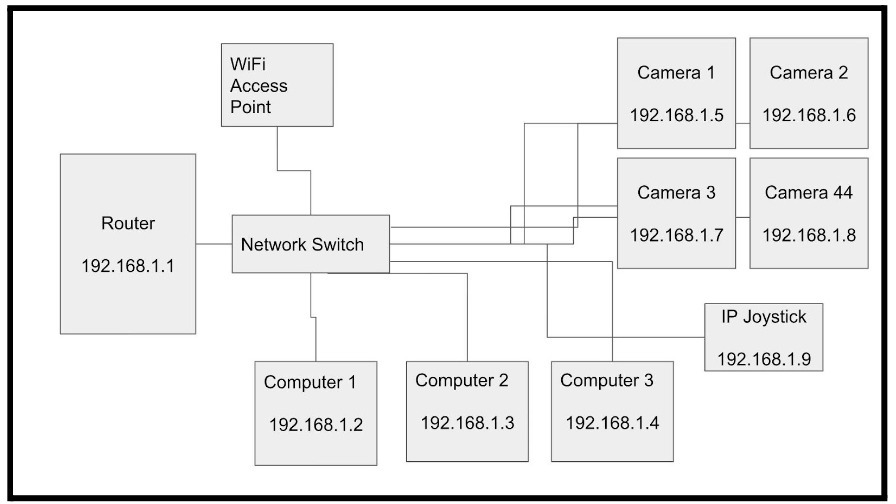
The table below is helpful for referencing IP addresses when you need them. For example, if a PTZ camera is controllable with your video production software, the camera’s unique IP address is often necessary to control it. Some software with web-server capabilities will use a port number to create a unique address for the software running on the network-connected computer. For example, if your main live streaming computer is running vMix, you may be using the vMix Social application which is controlled by a web-browser interface. If the computer’s IP address is 192.168.1.70, vMix will automatically use port 8089 on the same base IP address to create a unique address to control vMix Social. Therefore, the IP address 192.168.1.70:8089 would open the controls for vMix Social.
IP Address | Device |
192.168.1.0 | Network Address |
192.168.1.1 | Router supplied by your Internet Service Provider |
192.168.1.2-59 | Used for office devices like office computers, printers, access points, and other IP connected devices |
192.168.1.60 | PTZOptics 20X – Main Camera in back of Church |
192.168.1.61 | PTZOptics 12X – Front Camera on Choir Area |
192.168.1.62 | PTZOptics 12X – Side Camera to on Stage |
192.168.1.63 | PTZOptics 30X – 2nd Camera in back of Church for Close Up Views |
192.168.1.64 | PTZOptics ZCam – Static Camera used for Drum Cage |
192.168.1.65 | PTZOptics ZCam – Static Camera used for Backstage |
192.168.1.66 | PTZOptics IP Joystick Controller |
192.168.1.70 | Main vMix Live Streaming Computer |
192.168.1.70:8089 | vMix Social Management Server |
192.168.1.71 | Pastor’s on-Stage Laptop |
192.168.1.72 | Computer Powering 2 Displays in Lobby using NDI® Studio Monitor |
192.168.1.73 | Computer Powering 2 Displays in Nursery using NDI® Studio Monitor |
192.168.1.74 | Computer Powering 2 Displays on Stage for Confidence Monitoring |
192.168.1.119* | iPad using NDI® Camera App (Wireless Camera) |
192.168.1.123* | Smartphone used for iOS camera control app |
*Assigned with DHCP |
The great thing about IP-based video production for so many users is that you likely already have a network in place at home. Thinking about your home network may help you make sense of the chart above. You may open up a whole new universe of possibilities where your existing network becomes the preferred method of video routing across your facility.
Need another camera shot? Just run a Cat-5e or better) cable to the camera. This single cable will give you high-quality video, a camera you can remotely control, and power for that camera in a single stroke. Want to send PowerPoint slides from a computer onstage back to the video production computer? No problem, everything is connected to the same network. Try using your home network with the NDI mobile app on your phone and see how easy it is to send video from your smartphone to your computer connected on the same network.
Once you have your LAN set up the way you want, it’s very easy to transition this workflow for a remote production. The PTZOptics Hive software, for example, is able to search the local area network and connect each source to the cloud for remote production. Once the Hive software is installed on a computer on the LAN, each source you connect to your studio can be connected to the cloud for sharing with others on your team. Many studios use both local and remote access options that are available in Hive. This is why there is a Local/Cloud toggle at the top of the interface. This allows you to quickly view your connection type and if you want, temporarily “lock” the studio into local only mode. This will stop other users from accessing the local sources on the network, even if you have shared access with them.
KEY TAKEAWAYS FROM THIS CHAPTER:
- Importance of IP Video Technologies: Technologies like NDI, RTSP, SRT, and Dante AV-H are crucial for enhancing remote content production capabilities. They allow for the efficient management and streaming of IP video signals, which are vital in modern broadcasting environments.
- Understanding IP Networking: Gaining some knowledge of IP networking is beneficial as it supports the effective use of IP video technologies. This knowledge helps in optimizing network setups for remote production.
- Role of Routers: Routers play a central role in network management. They provide internet access, manage LAN rules, and can automatically assign IP addresses using DHCP. Some routers also include built-in network switches or Wi-Fi capabilities, enhancing network connectivity.
- Use of Wireless Access Points (WAPs): WAPs are distributed across areas to extend Wi-Fi coverage. They are often connected via Ethernet and many support Power Over Ethernet (PoE), allowing them to receive power through network cables from PoE-enabled equipment.
- Benefits of VLANs: Virtual LANs (VLANs) are used to create segmented parts of a network, ideal for IP video to reduce traffic and prevent packet collisions. VLANs improve network security and efficiency by limiting access to network resources to specific devices.
- Network Configuration for Video Traffic: Setting up a VLAN specifically for video traffic helps in managing bandwidth and enhances the reliability of video streaming within a network.
- Remote Production Software: Software solutions like PTZOptics Hive facilitate the integration of local video sources with cloud-based production platforms. This software can identify and connect networked video sources for remote access and collaboration.
- Local and Cloud Access: Studios often toggle between local and cloud access to manage how video sources are shared and accessed within the network. Features like a Local/Cloud toggle help in quickly switching the operational mode of the studio, providing control over local sources and preventing unauthorized remote access.
Optimizing for Bandwidth (Chapter 10)
Recent Comments
Category
- Audio (1)
- AV Management (2)
- Book (18)
- Education (1)
- NAB Show (1)
- NDI (4)
- PTZ Controls (6)
- Remote Production Software (20)
- Sports (3)
- Studio Management (2)
- Training (7)
- Uncategorized (4)
- vMix (3)
New Tags
auto-tracking AV Management AV Monitoring bandwidth Book broadcasting broadcast technology camera compatibility camera presets camera settings cloud-based platform CloudFlex color correction Education Epiphan Hive Hive PTZ Hive Setup innovative technology IP Video live production live streaming metro NAB Show NAB Show 2024 NDI NDI Video Source Peplink professional broadcasting professional video PTZ camera control PTZ Controls PTZOptics PTZOptics Hive real-time collaboration remote production remote video production Sports Sports Broadcasting USB Cameras video broadcasting video content production video equipment video production vmix

